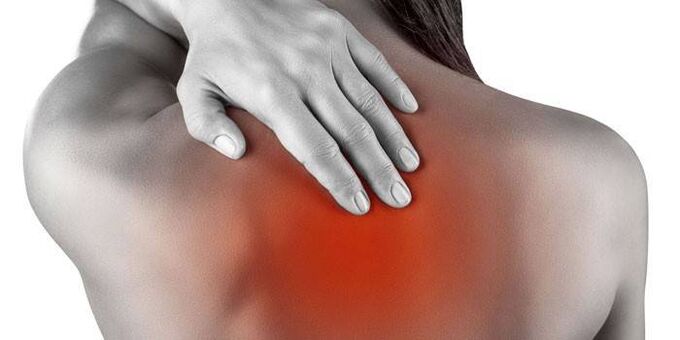The most common problem with the spine is osteochondrosis. The disease can affect any part of the spine that is exposed to increased stress. Manifested at any age, more often the older generation belongs to the risk group. Symptoms of osteochondrosis of the thoracic spine are exacerbated by an acute attack of pain.
What is osteochondrosis of the thoracic spine in women
This disease is characterized by dystrophic and degenerative disorders of the spine, changes in the structure and shape of the intervertebral discs. Spinal chest osteochondrosis progresses to the age of 40 and is carried on the feet by many patients. This cannot be done because over time, the intercostal nerves become constricted; disability is not excluded. The upper thoracic vertebrae are involved in the pathological process and the patient guesses the disease with the characteristic chest pain.
Symptoms of breast osteochondrosis in women
It is problematic to define the disease of the better sexes because its symptoms are similar to the manifestations of other pathological conditions in the female body. For example, an acute pain attack in the peritoneal region may be the cause of damage to the mammary glands or may be the result of a heart attack, angina pectoris. You must take heart drugs to refute or confirm the guess. The lack of positive dynamics indicates that the heart is healthy and there are obvious problems with the spine.
Some patients believe that the pain is caused by chronic gastritis or duodenal ulcer. In fact, these are characteristic signs of osteochondrosis of the breast in women, which only intensify over time, becoming more intense, lasting. The diagnosis can be confused with shingles, as the pain can be localized in the same area. To properly distinguish the disease, the characteristics of some symptoms are not sufficient, an integrated approach to the progressive problem is needed.

Symptoms of chest osteochondrosis in men
The disease can develop in the male body, especially if you follow a sedentary lifestyle, choose hard physical work for yourself. Signs of thoracic osteochondrosis in men may be confused with acute pleurisy, angina pectoris, scoliosis, cholecystitis, and other myocardial pathologies. You can use medications to make sure that this is not a heart attack, but only the prescribing doctor prescribes heart tablets. Superficial self-healing is completely ruled out. This disease causes not only chest pain, but also other symptoms:
- numbness in the legs;
- creeps on the skin;
- increased muscle tension;
- symptoms of decreased potency;
- lumbago in the interscapular region.
How does chest osteochondrosis manifest itself?
The disease begins with an acute attack of pain that localizes in the chest, resembling a heart attack. At first, we experience painful sensations when turning, with a sharp tilt of the body and deep breathing. Over time, dorsalgia also reminds him of the resting stage. Because the focus of the pathology is localized in the upper chest, in the absence of appropriate treatment relative to the myocardium, complications can be observed, affecting the cardiovascular system. In addition, thoracic osteochondrosis presents with the following neurological symptoms:
- climbing legs;
- reflex tension in the muscles of the back and chest;
- pelvic organ dysfunction;
- numbness of the abdomen and upper sternum;
- pain exacerbated by moderate exercise.
How does osteochondrosis of the chest hurt?
Not all patients know what chest osteochondrosis looks like - the symptoms do not resemble themselves for some time. The location of the lesion can be determined clinically, but the patient should first report complaints of back pain or lumbago between the shoulder blades. If they are not treated in time, the symptoms of the characteristic disease will only increase. Osteochondrosis chest pain is different in nature, depending on the extent of the pathological process and the characteristics of the body.

Exacerbation of chest osteochondrosis
If the trunk remains seated for a long time in progressive osteochondrosis, the occurrence of dorsago is not ruled out. This is an acute attack of pain that can radiate to the cervical and lumbar spine while interfering with breathing, paralyzing the movement of the clinically ill patient. Exacerbation of thoracic osteochondrosis begins with sharp attacks on the left and right sides of the sternum that are difficult to stop with medication. Such a condition cannot be simulated as it confuses the patient to the bed, deprives him of sleep and rest.
If we talk about the growing symptoms of dorsalgia, this sign of chest osteochondrosis develops later. It appears in the hypochondria, but before that it develops unnoticed for 2-3 weeks. Extensive damage to the intercostal spaces begins with a general feeling of discomfort when changing the position of the trunk, which is later replaced by a dangerous pain attack in the spinal region. Among the complications, doctors distinguish between gallbladder inflammation and shingles.
Attacks of osteochondrosis of the thoracic region
In the case of such an unpleasant disease, the nerve fibers are affected, so the attack is always accompanied by acute pain, which has an unexplained localization in the early stages of development. At first, unpleasant sensations are observed with sudden movements, increased activity, coughing and sneezing, but then the specific symptoms are reminiscent even at night when the body relaxes and rests.
A frequent attack of pectalgia, when the acute pain is concentrated in the front of the chest, does not allow inhalation and exhalation, literally paralyzes the whole body, disrupts the normal rhythm of life. In the absence of timely therapy, such painful attacks of osteochondrosis of the thoracic region only intensify, invalidating a once healthy person.

Symptoms of advanced osteochondrosis
The disease progresses to a degree of displacement of the intervertebral discs, disrupting the shape and structure of the spinal column. For the patient, it is an acute pain that does not allow the body to turn around, restrict movement and physical activity, which is one of the main causes of an unstable emotional sphere. During the pathological process, the systemic circulation is disrupted and the progressive symptoms of advanced osteochondrosis lead to such health complications:
- myocardial dystrophy;
- renal dysfunction;
- intervertebral hernia;
- symptoms of decreased potency;
- shingles;
- dystrophy of other parts of the spine;
- extensive lesions of the internal organs.

















































